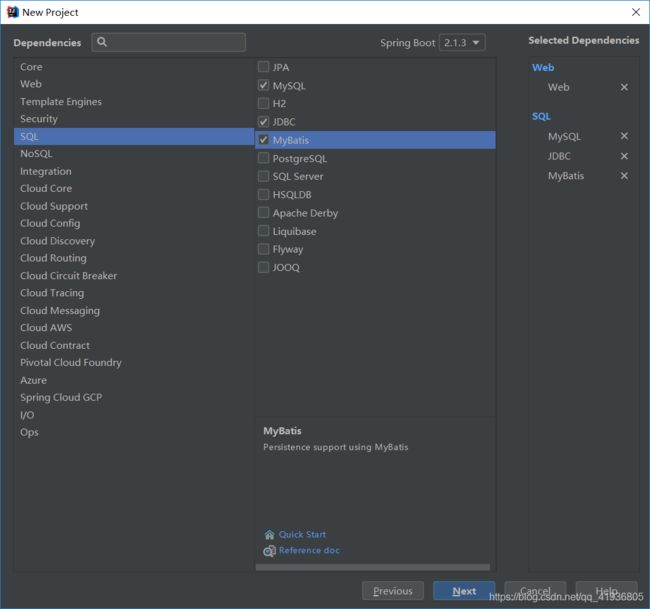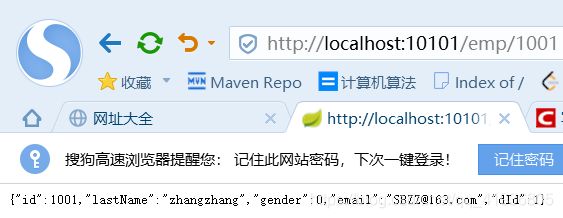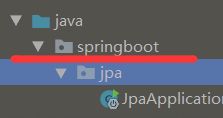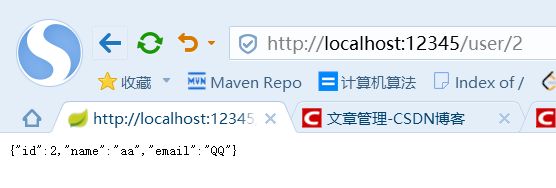SpringBoot框架学习(六)——数据访问
文章目录
- 十、数据访问
-
- 1.整合基本JDBC与数据源
- 2.DataSourceInitializer
- 3.案例
- 4.配置Druid
-
- <1>配置属性
- <2>配置Druid数据源监控
- 5.整合Mybatis与springboot
-
- <1>搭建环境
- <2>封装表的数据
- <3>使用注解来用mybatis进行crud操作
-
- 1.创建两张表的接口
- 2.向页面发送请求,执行请求对应的数据
- 3.自定义Mybatis的Config
- <4>使用配置文件来用mybatis进行crud操作
-
- 1.创建一个接口
- 2.写配置文件
- 3.写Sql映射文件
- 4.要让Mybatis检索到映射文件的存在
- 5.可以在2的配置 文件中设置自己想实现的设置
- 6.Spring Data JPA
-
- <1>SpringData简介
- <2>JPA与SpringData
- <3>导入环境
- <4>整合JPA案例
-
- 1.首先创建一个User类,创建几个私有属性,并且生成get Set方法
- 2.编写一个DAO接口来操作实体类对应的数据表(Repository)
- 3.在yml文件中进行基本的配置
- 4.测试
- 5.crud
十、数据访问
1.整合基本JDBC与数据源
创建工程,导入基本的jar包

然后再resource目录下新建一个yml配置文件连接到我们的oracle数据库
spring:
datasource:
username: SYSTEM
password: xxx
url: jdbc:oracle:thin:@127.0.0.1:1521:xe
driver-class-name: oracle.jdbc.OracleDriver
2.DataSourceInitializer
首先,DataSourceInitializer是ApplicationListener的一个继承类,是一个监听器
作用
1.runSchemaScripts()运行建表语句
2.runDataScripts() 运行插入数据的sql语句
生效方法
只需要将resource目录下的sql文件命名为schema-xx.sql或者data-xx.sql就可以进行自动识别了
3.案例
首先再resource目录下创建一个.sql文件
create table springTest(id NUMBER(8),interest NUMBER(5,2),seven NUMBER(5,2))
然后把这个sql文件添加路径到我们的yml文件中
schema:
- classpath:160900.sql
然后测试我们的代码
@Controller
public class HelloController {
@Autowired
JdbcTemplate jdbcTemplate;
@ResponseBody
@GetMapping("/query")
public Map<String, Object> map() {
List<Map<String, Object>> list =
jdbcTemplate.queryForList("SELECT id,interest from springTest");
return list.get(0);
}
}
向/query发送一个get请求,然后去进入到localhost:10101/就可以看见一个json格式的数据显示出来
(这里已经像表中自动填入了一行数据,并且设置了端口号是10101,不然会出405错误)
4.配置Druid
<1>配置属性
首先先用maven日常引入druid的配置在pom文件里
<dependency>
<groupId>com.alibabagroupId>
<artifactId>druidartifactId>
<version>1.1.12version>
dependency>
接下来在yml文件里把数据源地址改成druid
type: com.alibaba.druid.pool.DruidDataSource
然后再进行一些其他配置
# 数据源其他配置
initialSize: 5
minIdle: 5
maxActive: 20
maxWait: 60000
timeBetweenEvictionRunsMillis: 60000
minEvictableIdleTimeMillis: 300000
validationQuery: SELECT 1 FROM DUAL
testWhileIdle: true
testOnBorrow: false
testOnReturn: false
poolPreparedStatements: true
# 配置监控统计拦截的filters,去掉后监控界面sql无法统计,'wall'用于防火墙
filters: stat,wall,log4j
maxPoolPreparedStatementPerConnectionSize: 20
useGlobalDataSourceStat: true
connectionProperties: druid.stat.mergeSql=true;druid.stat.slowSqlMillis=500
然后重新运行发现还是老样子,并没有提示以上属性,那是因为我们需要手动配置
@Configuration
public class DruidConfig {
@ConfigurationProperties(prefix = "spring.dataSource")
@Bean
public DataSource druid(){
return new DruidDataSource();
}
}
重新进行debug
发现已经包含了上面的属性
<2>配置Druid数据源监控
#配置druid的监控
#1.配置一个管理后台的Servlet
@Bean
public ServletRegistrationBean statViewServlet(){
ServletRegistrationBean bean = new ServletRegistrationBean(new StatViewServlet(), "/druid/*");
Map<String, String> initParams = new HashMap<>();
initParams.put("loginUsername","admin");
initParams.put("loginPassword", "123456");
initParams.put("allow", "");//默认所有人都能访问
initParams.put("deny", "192.168.243.1");//设置谁不能访问
bean.setInitParameters(initParams);
return bean;
}
#2.配置一个监控的filter
@Bean
public FilterRegistrationBean webStatFilter() {
FilterRegistrationBean filterRegistration = new FilterRegistrationBean();
filterRegistration.setFilter(new WebStatFilter());
Map<String, String> initParams = new HashMap<>();
initParams.put("exclusion", "*.js,*.css,/druid/*");//设置谁可以不被拦截
filterRegistration.setInitParameters(initParams);
filterRegistration.setUrlPatterns(Arrays.asList("/*"));
return filterRegistration;
}
}
重新运行打开localhost:10101/druid会自动跳转到login界面,进行登录即可,然后就可以看到监控后台的界面了。
5.整合Mybatis与springboot
<1>搭建环境
新建工程,添加mybatis依赖,然后建立之后再添加druid依赖
<dependency>
<groupId>com.alibabagroupId>
<artifactId>druidartifactId>
<version>1.1.8version>
dependency>
然后重新新建yml文件,连接数据库,并且配置druid,书写druid的config类进行配置,可以参考上面,这里不多解释了。
添加sql文件的路径
schema:
- classpath:sql/160900.sql
然后添加log4j的pom依赖,不然会报错说找不到log4j,然后运行,来到localhost:druid,熟悉的界面
<2>封装表的数据
Employee
package springbootmybatis.mybatisdruid.bean;
public class Employee {
private Integer id;
private String lastName;
private Integer gender;
private String email;
private Integer dId;
public Integer getId() {
return id;
}
public String getLastName() {
return lastName;
}
public Integer getGender() {
return gender;
}
public String getEmail() {
return email;
}
public Integer getdId() {
return dId;
}
}
department
package springbootmybatis.mybatisdruid.bean;
public class department {
private Integer id;
private String departmentName;
public Integer getId() {
return id;
}
public String getDepartmentName() {
return departmentName;
}
}
<3>使用注解来用mybatis进行crud操作
1.创建两张表的接口
#指定是一个操作数据库的mapper
@Mapper
public interface DepartmentMapper {
}
另一张表也一样,以这张表为例
@Mapper
public interface DepartmentMapper {
@Select("select * from department where id =#{id}")
public Department getDeptById(Integer id);
@Delete("select * from department where id=#{id}")
public Department deleteDeptById(Integer id);
@Insert("insert into department(departmentName)values (#{departmentName})")
public Department insertDept(Department department);
@Update("update department set departmentName =#{departmentName} where id=")
public Department updateDept(Department department);
}
2.向页面发送请求,执行请求对应的数据
@RestController#不返回页面直接返回json
public class DeptController {
@Autowired
DepartmentMapper departmentMapper;
@GetMapping("/dept/{id}")
public Department getDepartment(@PathVariable("id") Integer id) {
return departmentMapper.getDeptById(id);
}
@GetMapping("/dept")
public Department insertDept(Department department) {
departmentMapper.insertDept(department);
return department;
}
}
然后运行来到对应页面测试即可(不要忘了创建表)
localhost:10101/dept/1
localhost:10101/dept?departmentName=LO
这时如果我们想要获得自增主键的话,只要在对应的语句前设置一个Option注解即可
@Options(useGeneratedKeys = true,keyProperty = "id")
@Insert("insert into department(departmentName)values (#{departmentName})")
public int insertDept(Department department);
3.自定义Mybatis的Config
#设置驼峰命名法
@org.springframework.context.annotation.Configuration
public class MybatisConfig {
@Bean
public ConfigurationCustomizer configurationCustomizer(){
return new ConfigurationCustomizer(){
@Override
public void customize(Configuration configuration) {
configuration.setMapUnderscoreToCamelCase(true);
}
};
}
}
在主类中设置一个注解MapperScan可以扫描所有的Mapper接口
@MapperScan(value = "springbootmybatis.mybatisdruid.mapper")
<4>使用配置文件来用mybatis进行crud操作
1.创建一个接口
public interface EmployeeMapper {
public Employee getEmpById(Integer id);
public void insertEmp(Employee employee);
}
2.写配置文件
<configuration >
configuration>
3.写Sql映射文件
<mapepr namespace="org.mybatis.example.BlogMapper">
<select id="selectBlog" resultType="Blog">
select * from Blog where id=#{id}
select>
mapepr>
4.要让Mybatis检索到映射文件的存在
来到配置界面
@Autowired
EmployeeMapper employeeMapper;
@GetMapping("/emp/{id}")
public Employee getEmp(@PathVariable("id") Integer id) {
return employeeMapper.getEmpById(id);
}
5.可以在2的配置 文件中设置自己想实现的设置
<settings>
<setting name="mapUnderscoreToCamelCase" value="true"/>
settings>
6.Spring Data JPA
<1>SpringData简介
概念:
SpringData项目的目的是为了简化构建基于Spring框架应用的数据访问技术,包括非关系型数据库,MapReduce框架,云服务等等;另外也包含对关系型数据库的访问支持
特点:
SpringData提供统一的API来对数据访问层进行操作;这主要是SpringDataCommons项目来实现的。SpringDataCommons让我们在使用sql,nosql的时候都有基于spring的统一标准,标准包括crud等等相关操作。
统一接口:
Repository
RevisionRepository
PS:
乐观锁机制:
认为数据一般情况下不会造成冲突,所以在数据进行提交更新的时候,才会正式对数据的冲突与否进行检测,如果发现冲突了,则让用户返回错误的信息,让用户决定如何去做。
CrudRepository
PagingAndSortingRepository
提供数据访问模板xxxTemplate
就像JDBCTemplate…
JPA与SpringData
<2>JPA与SpringData
(1)JPARepositor基本功能
(2)定义符合规范的方法命名
(3)@Query自定义查询,定制查询Sql
(4)Specifications查询(SpringDataJPA支持JPA2.0 的Criteria查询)
<3>导入环境
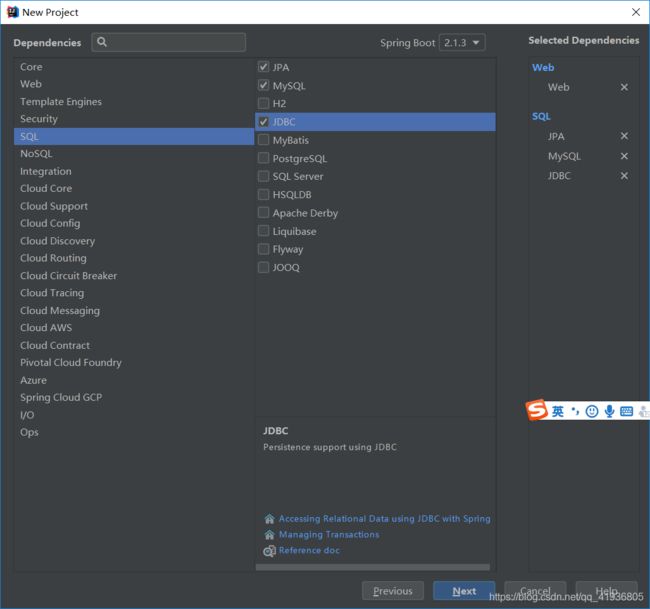
继续在resource目录下创建application.yml进行我们的数据库连接
spring:
datasource:
username: SYSTEM
password: 1
url: jdbc:oracle:thin:@127.0.0.1:1521:xe
driver-class-name: oracle.jdbc.OracleDriver
<4>整合JPA案例
1.首先创建一个User类,创建几个私有属性,并且生成get Set方法
package springboot.entity;
public class User {
private Integer id;
private String name;
private String email;
public Integer getId() {
return id;
}
public void setId(Integer id) {
this.id = id;
}
public String getName() {
return name;
}
public void setName(String name) {
this.name = name;
}
public String getEmail() {
return email;
}
public void setEmail(String email) {
this.email = email;
}
}
在此基础上,使用JPA注解配置映射关系,并且标记主键属性,列属性,和其他属性
package springboot.entity;
import javax.persistence.*;
#使用JPA注解配置映射关系
@Entity #告诉JPA这是一个实体类(和数据表映射的类)
@Table(name = "tbq_user") #@Table来指定和哪个数据表对应;如果省略默认表名默认就叫所谓的类名也就是user(还得小写)
public class User {
@Id #这是一个主键
@GeneratedValue(strategy = GenerationType.IDENTITY)#自增主键
private Integer id;
@Column(name = "last_Name",length = 50)#这是和数据表对应的一个列
private String name;
@Column #默认列名就是属性名
private String email;
public Integer getId() {
return id;
}
public void setId(Integer id) {
this.id = id;
}
public String getName() {
return name;
}
public void setName(String name) {
this.name = name;
}
public String getEmail() {
return email;
}
public void setEmail(String email) {
this.email = email;
}
}
2.编写一个DAO接口来操作实体类对应的数据表(Repository)
//继承JpaRepository来完成对数据库的操作
public interface UserRepository extends
JpaRepository<User,Integer> {//传入操作的数据表和主键类型
}
3.在yml文件中进行基本的配置
jpa:
hibernate:
ddl-auto: update
# 更新或者创建数据表结构
show-sql: true
# 控制台显示代码
4.测试
运行后![]()
的确创建出来了
5.crud
写一个UserController方法,向里面注入userRepository,这里面封装好了crud操作,直接调用即可
package springboot.controller;
import org.springframework.beans.factory.annotation.Autowired;
import org.springframework.web.bind.annotation.GetMapping;
import org.springframework.web.bind.annotation.PathVariable;
import org.springframework.web.bind.annotation.RestController;
import springboot.entity.User;
import springboot.repository.UserRepository;
@RestController
public class UserController {
//想要进行增删改查,直接注入userRepository即可
@Autowired
UserRepository userRepository;
@GetMapping("/user/{id}")
public User getUserById(@PathVariable("id") Integer id) {
User user = userRepository.findOne(id);
return user;
}
@GetMapping("/user")
public User insertUser(User user) {
User save = userRepository.save(user);
return save;
}
}
